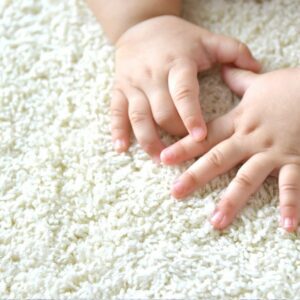The Ultimate Guide to Frieze Carpets
The Definitive Guide to Frieze Carpet
Origins and Development
Frieze carpeting, with its twisted fibers and resilient nature, has roots that trace back to the shag carpets of the 1960s and 1970s. However, modern advancements have transformed it into a more sophisticated and durable option for today’s homeowners.
Unlike the longer fibers of traditional shag carpet, frieze features tightly twisted fibers that create a dense, curly surface. This distinctive construction not only enhances its aesthetic appeal but also contributes to its longevity and ease of maintenance.
The Historical Tapestry of Frieze Carpets
The origins of frieze carpets are intricately linked to the ancient craft of carpet weaving, which dates back thousands of years. Historically, carpets were primarily functional items, designed to provide warmth and insulation. Over time, their aesthetic and decorative value gained prominence, leading to the development of various styles and techniques.
The concept of twisting fibers for added texture and durability is a technique that has been employed in various forms throughout carpet-making history. This method was refined over centuries, laying the groundwork for the modern frieze carpet.
The Evolution from Shag to Frieze
The shag carpets of the 1960s and 1970s are considered the direct ancestors of today’s frieze carpets. Characterized by their long, loose fibers, shag carpets were emblematic of the era’s quest for luxury and comfort. However, they were also notoriously difficult to clean and maintain.
The transition from shag to frieze carpets can be seen as a response to these practical challenges, with the modern frieze incorporating the visual appeal of shag but with shorter, tightly twisted fibers.
This evolution was made possible by advancements in carpet manufacturing technology, which allowed for precise control over the twisting process, resulting in the durable, resilient texture that defines frieze carpeting today.
Technological Innovations in Fiber Twisting
The development of frieze carpets has been significantly influenced by technological innovations in yarn twisting and tufting techniques.
Modern manufacturing processes involve twisting the carpet fibers multiple times, creating the carpet’s signature curled texture. This not only enhances the carpet’s aesthetic appeal but also increases its resistance to wear and tear, making it more durable than its predecessors.
The introduction of heat-setting processes further solidified the twist, ensuring that the fibers retain their shape over time.
Cultural Influences and Modern Adaptations
Frieze carpeting has also been shaped by changing cultural preferences and lifestyles. The move towards more casual, comfortable living spaces has driven the popularity of frieze carpets, which offer both comfort and a relaxed aesthetic. Additionally, the growing awareness of environmental sustainability has influenced the development of frieze carpets. Manufacturers now increasingly use recycled materials and sustainable practices, reflecting consumers’ desire for eco-friendly home decor options.
References
- “The Carpet and the Connoisseur: The James F. Ballard Collection of Oriental Rugs” by Walter B. Denny. This reference provides insights into the historical significance of carpet weaving and how ancient techniques have influenced modern carpet styles, including frieze.
- “Carpet Technology” by A. Richard Horrocks and Subhash C. Anand. This book details the technological advancements in carpet manufacturing, particularly the development of twisting and tufting techniques that are crucial to the production of frieze carpets.
Summary
By exploring the rich tapestry of history, technology, and culture that has shaped the development of frieze carpets, it becomes evident that this flooring option is more than just a practical choice—it’s a reflection of centuries of innovation and stylistic evolution.
Guide to Frieze Carpets: Durability, Comfort, and Style Explained
In the diverse world of home decor, frieze carpets stand out for their unique blend of style, comfort, and durability. This guide delves into the intricacies of frieze carpeting, offering insights into its origins, manufacturing processes, and the latest trends. Whether you’re considering the best frieze carpet for your home or seeking advice on the best vacuum for frieze carpet, this article covers all bases.
Manufacture and Materials of Frieze Carpets
The manufacture of frieze carpeting is a sophisticated process. It combines advanced technology with intricate craftsmanship. This section outlines the procedure of making frieze carpets. It highlights the materials used and the steps involved in creating this durable and stylish flooring option.
Materials Used
The primary material in frieze carpeting is synthetic fibers, with nylon and polyester being the most popular choices due to their durability and stain resistance.
Nylon, known for its resilience and ability to retain its shape, makes for a long-lasting frieze carpet that can withstand high traffic and frequent cleaning.
Polyester, on the other hand, offers exceptional softness and color clarity, providing a plush feel and vibrant hues that do not easily fade over time.
Some manufacturers also explore eco-friendly options, such as recycled plastics or bio-based materials, to minimize environmental impact without compromising on quality.
Twisting Process
The distinctive texture of frieze carpets comes from its tightly twisted fibers. The process begins with the production of synthetic yarn, which is then twisted at high speeds in industrial machines.
This twisting not only imparts the carpet’s characteristic curly appearance but also locks the fibers into a durable structure.
Typically, the yarn twists up to 10 times more than standard carpet fibers do. This creates a kinked texture that improves the carpet’s resilience and its ability to hide dirt and footprints.
Heat Setting
After twisting, the yarn undergoes a heat setting process. This crucial step stabilizes the fibers, ensuring they retain their twisted form and do not unravel over time. Heat setting involves exposing the twisted yarn to high temperatures, which “sets” the twists, locking them in place.
This process contributes significantly to the frieze carpet’s durability, making it an excellent choice for high-traffic areas.
Tufting and Finishing
The next phase in manufacturing frieze carpeting is tufting, where the twisted and heat-set yarn is inserted into a backing material to create the carpet’s structure.
Advanced tufting machines accurately stitch the yarn into the backing, forming the dense, plush pile characteristic of frieze carpets.
Following tufting, the carpet undergoes additional finishing processes, such as dyeing and applying stain-resistant treatments. These finishing touches not only enhance the carpet’s aesthetic appeal but also improve its performance and longevity.
Quality and Performance Enhancements
Throughout the manufacturing process, quality control measures are in place to ensure the frieze carpet meets strict standards for durability, comfort, and style.
Innovations in fiber technology and treatment methods continue to enhance the performance of frieze carpets. They offer homeowners superior stain resistance, color retention, and ease of maintenance.
In summary, the manufacture of frieze carpeting involves a meticulous process. Procedures that transform synthetic fibers into a highly durable, comfortable, and stylish flooring option.
From the choice of materials to the advanced production techniques, each step is designed to produce high performance frieze carpets. Products that stand the test of time, offering both aesthetic appeal and practical benefits to homeowners.
Advantages and Disadvantages of Frieze Carpets
Advantages
- Durability: The tightly twisted fibers of frieze carpeting provide exceptional durability, making it ideal for busy households.
- Comfort: Its plush nature offers a soft, comfortable surface underfoot.
- Style: Frieze carpets come in a wide range of colors and patterns, fitting various decor styles.
- Maintenance: The twisted fibers help conceal dirt and footprints, reducing the appearance of wear.
Disadvantages
- Cost: High-quality frieze carpets can be more expensive upfront compared to other types of carpeting.
- Cleaning Challenges: The dense fibers may require a specific type of vacuum cleaner, like the best vacuum for frieze carpet, to effectively remove dirt without damaging the carpet.
Environmental Impact and Long-term Costs
When considering frieze carpeting, it’s essential to factor in its environmental impact. The best frieze carpets are often made from recyclable or sustainable materials, offering an eco-friendly option for environmentally conscious homeowners.
Moreover, their durability means a longer replacement cycle, reducing waste and long-term costs.
Performance Differences: Frieze Carpets vs. Other Types
Comparing frieze to other carpet types, such as plush carpet, highlights significant performance differences. While plush carpets offer a uniform, smooth texture, frieze’s twisted fibers provide a more informal look and superior resistance to wear and tear.
These differences make frieze an excellent choice for areas with high foot traffic or pets.
Emerging Trends
The carpet industry continues to evolve, with trends leaning towards more sustainable and innovative designs.
Frieze carpeting is no exception, with manufacturers experimenting with recycled materials and advanced fiber technologies to enhance performance and environmental sustainability.
Conclusion
Frieze carpets embody the perfect blend of durability, comfort, and style, making them a top choice for homeowners looking for a practical yet stylish flooring option.
Whether you’re drawn to the best frieze carpet for its aesthetic appeal or the best vacuum for frieze carpet for maintenance ease, understanding the nuances of frieze carpeting can help you make an informed decision.
As we’ve explored, from its twisted fibers to its environmental impact and performance differences, frieze carpeting offers a versatile and durable solution for modern living spaces.

